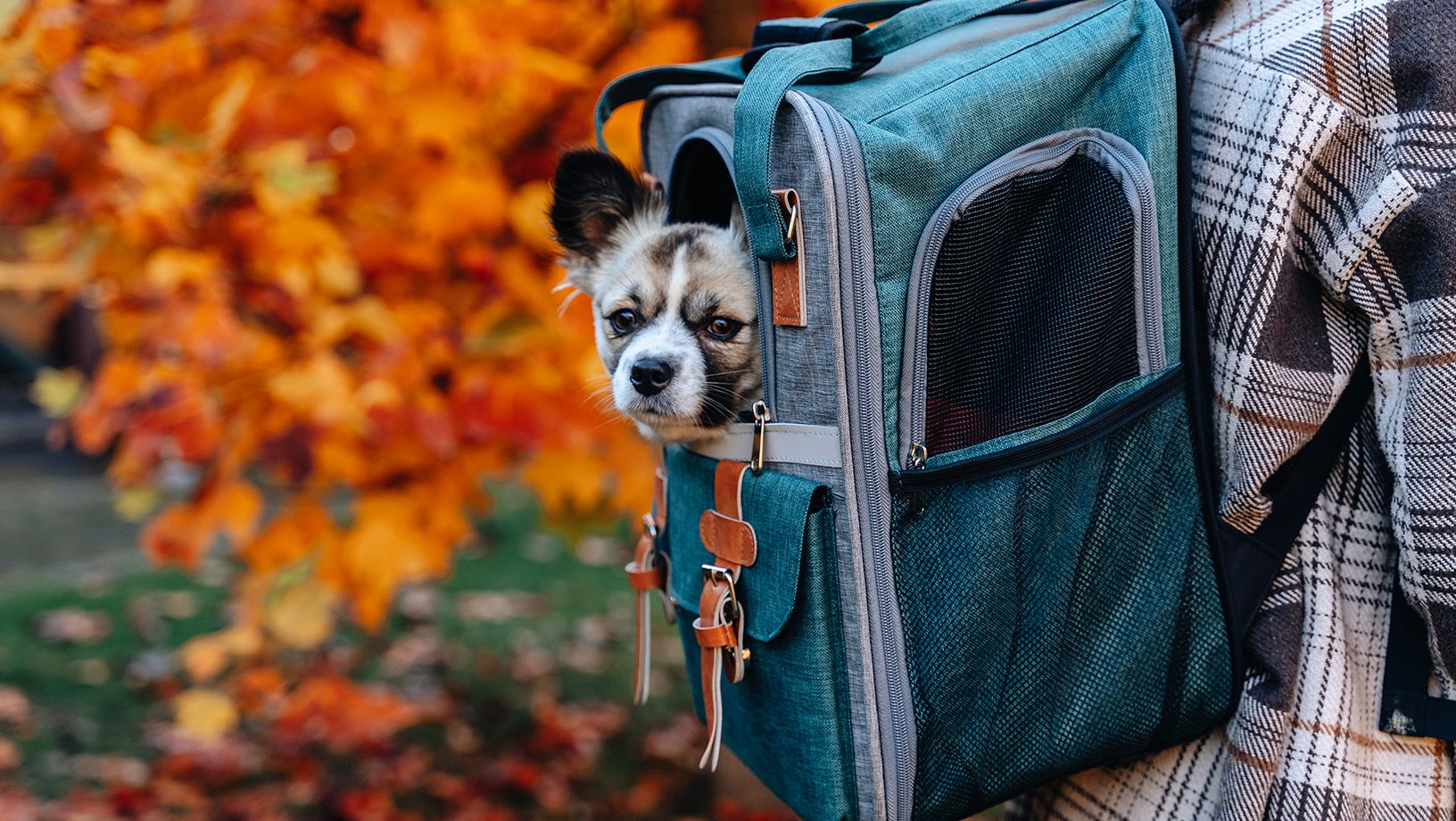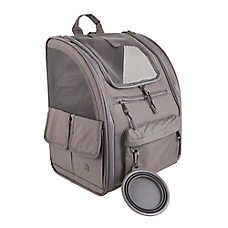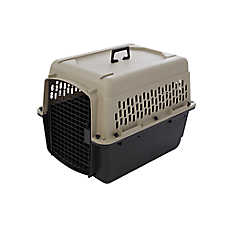Choosing the Right Dog Carrier

In this Article
Whether you’re traveling with your dog across town or across the country, the right dog carrier can help to make the trip safer, easier and more comfortable for your canine companion. Selecting the right carrier for your dog and your mode of transportation is essential. Here are a few tips to help you make the best choice.
Dog carriers 101
A dog or puppy carrier is a portable enclosure that lets you safely transport your pup. Carriers come in lots of styles, sizes and materials to cater to your specific travel needs, style and preferences.
Dog carriers have several purposes:
- Safety: When traveling with your dog, carriers protect your pup from potential hazards, keep them firmly under your control and prevent them from escaping.
- Comfort: Many carriers are designed with soft interiors and excellent ventilation to ensure your dog has a comfortable traveling experience.
- Convenience: Using a carrier provides an easier way to bring your dog along on car rides, flights, public transportation or long walks and hikes.
- Compliance: For air travel, you’ll need a dog carrier that meets the requirements of your airline and transportation authority regulations.
Types of dog carriers
Dog carriers are among the essential list of dog and puppy supplies and come in several categories:
- Soft sided carriers: These are lightweight, flexible carriers made from durable materials like nylon or polyester. Mesh panels provide ventilation and visibility. Soft-sided carriers are often designed to collapse, making them easier to store.
- Hard sided carriers or dog crates: Built with a rigid plastic or metal materials, hard-sided carriers offer more protection for your pup. In addition to being easier to clean and more resistant to chewing than softer products, hard-sided carriers are excellent for car travel as they provide more protection in accidents.
- Backpacks: Backpack carriers are perfect for small dogs or puppies, and they allow you to transport your dog hands-free. Dog backpacks are perfect for hiking or cycling with your dog or navigating safely through crowded areas.
- Slings: Dog slings are worn over the shoulder, allowing your pup to rest comfortably at your side. These carriers are perfect for small dogs and short trips.
- Wheeled carriers: Dog carriers with wheels are ideal for larger dogs or for owners who have difficulty carrying their pets.
- Dog purse: A dog purse is a stylish and portable bag designed for very small dogs. Often resembling a designer handbag or tote, a dog bag offers a great blend of fashion and functionality.
How to choose the right dog carrier
There are several factors to consider when choosing the right carrier for your pup:
- Size and weight: A dog carrier must be large enough for your pup to stand, turn around and lie down comfortably. The carrier should also support your dog’s weight without causing you to strain. Check the weight limit specified by the manufacturer to ensure that a carrier can safely transport your dog.
- Type of travel: A carrier that works for quick trips around town may not be right for long car trips, airline flights or taking your dog camping. For car trips, look for carriers that can be securely fastened with seatbelts. When flying with your dog in the cabin, you’ll need an airline-approved carrier that fits under the seat.
- Comfort and safety features: Soft padding, adequate ventilation and secure closures will help keep your dog safe and comfortable.
- Convenience: Carriers with pockets make it easier to bring accessories along.
What to look for in a dog carrier
Keep these criteria in mind when comparing dog carrier products:
- Durability: Look for a carrier made from durable, high-quality materials that can withstand wear and tear. Strong stitching and secure zippers will help prevent accidental escapes or damage.
- Ventilation: Adequate ventilation is essential to keep your dog comfortable and to prevent overheating. Look for carriers that have ample ventilation holes or mesh windows.
- Cleaning: You’ll need to clean your carrier often to maintain good hygiene and to keep your dog comfortable. A carrier with removable and washable pads makes cleaning easy. Hard-sided carriers should be easy to wipe down and sanitize, while soft-sided carriers should be made from materials that can be easily spot cleaned.
- Portability: Ideally, your carrier should make it easy to transport your pup without causing much strain. Features like shoulder straps, handles or wheels will make transportation easier. Carriers that can be folded or collapsed are more convenient for storage.
FAQs
What is a TSA-approved pet carrier?
A TSA-approved pet carrier meets the Transportation Security Administration's guidelines for traveling with pets in the cabin of an aircraft. These carriers typically have specific size restrictions, secure closures and adequate ventilation. However, it's important to note that while a carrier may be TSA-approved, airlines may have their own additional requirements.
Are pet carriers safe for dogs?
When used correctly, pet carriers are safe for dogs. They provide a secure space during travel, preventing your pet from roaming freely in vehicles or public spaces. To ensure safety, choose a carrier that's the appropriate size for your dog, has proper ventilation and is made from durable materials. Always supervise your pet when in the carrier and never leave them unattended for long periods.
How long can a dog stay in a carrier?
The duration a dog can comfortably stay in a carrier depends on factors like the dog's size, age and temperament, as well as the carrier's size and features. For short trips of a few hours, most dogs will be fine in a properly sized carrier. For longer journeys, it's important to provide regular breaks for water, bathroom needs and stretching. Always monitor your dog for signs of distress or discomfort.
Can I use a regular bag as a dog carrier?
While it might be tempting to use a regular bag as a dog travel bag, it's not recommended. Purpose-built dog carriers are designed with features crucial for your pet's safety and comfort, such as proper ventilation, secure closures and appropriate sizing. Regular bags lack these essential features and could potentially be unsafe or uncomfortable for your dog.
How do I get my dog used to a carrier?
Introducing your dog to a carrier should be a gradual process. Start by leaving the carrier open in a familiar area, allowing your dog to explore it freely. Place treats or toys inside to create positive associations. Gradually increase the time your dog spends in the carrier, always rewarding calm behavior. Practice short trips around the house or yard before attempting longer journeys. Patience and positive reinforcement are key to helping your dog feel comfortable in their carrier.
Need other supplies while you’re shopping for dog training products? PetSmart also carries dog food, dog beds, dog treats, leashes & harnesses, flea & tick meds and more.
PetSmart also offers services such as dog grooming services, expert dog training, safe and comfortable PetsHotel stays, and Doggie Day Camp for your pup to play and socialize. Services are available in select locations—check your local PetSmart to see what’s offered near you.
PetSmart offers convenient shopping with Curbside Pickup or in-store pickup. Need something today? We have select items available for Same-Day Delivery in most areas powered by DoorDash.
For items you purchase frequently, PetSmart has Autoship that automatically delivers the items you want to your door as often as you’d like. Check the website to see which items are eligible.
Information in this article is not intended to diagnose, treat or cure your pet and is not a substitute for veterinary care provided by a licensed veterinarian. For any medical or health-related advice concerning the care and treatment of your pet, contact your veterinarian.






